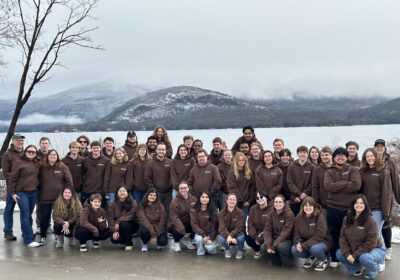The eyelash expedition
DINK! DINK! DINK!
Castleton’s herpetology class is in Costa Rica for April break. The piercing metallic calls of the diminutive dink frog penetrate the rainforest. We are searching for, among other critters, the eyelash viper, a beautiful, venomous snake that our guide says is found here.
Unfortunately, it is late and we will call it a night without catching a glimpse of this variable snake that comes in green, brown, peach, yellow, and other colors.
Herpetology is the study of amphibians and reptiles, so the class, led by professor Cynthia Moulton and myself, spent time identifying them. In the tropics, where biodiversity is great and the landscape relatively unexplored, positive identification can be difficult.
Coloration in frogs is notoriously variable – I think I found a narrow-headed tree frog, but it was browner and with a different pattern than the picture in our field guide. There are no anoline lizards in our books with a light-blue stripe over the shoulders. There is one with a white stripe, though the rest of the body is much darker.
Are they the same?
Still, success was often at hand. The green-and-black poison dart frogs, spiny-tailed iguanas, blunt-headed tree snakes, wood-colored salamanders and others were easily identified. While herpetology was our focus, the trip opened our eyes to other rainforest dwellers including scarlet macaws, three-toed sloths and florescent scorpions to name just a few.
The collection by one of our guides of a juvenile bush racer snake we found led to a discussion of the merits and morals of collecting ‘herps’ from the wild for display in zoos, for use in captive-breeding programs, and for sale in the pet trade. At some level, all of these have benefits and costs. Our interactions with our environments are fraught with moral gray areas. Sometimes, a practical assessment of ecological and societal impacts trumps moral responsibilities to wildlife.
Sometimes, it does not.
On our last night, we return to the forest dominated by the call of the dink frog. We are moving past common rain frogs and helmeted basilisk lizards that previously had been fascinating. We are looking for the eyelash viper. We are turning back soon and tomorrow we leave the rainforest for the concrete jungle of San Jose and the plane back to North America.
I find a brown vine snake, a nice consolation prize. It is pencil-thin, four-feet long and gray, brown, and white with an elongated head. It isn’t dangerous to humans, though it does have fangs in the back of its mouth that deliver venom to lizard and frog prey. It has an impressive open-mouthed defensive display that shows off a dark purple coloration on the inside of its mouth outlined by white lips.
We are admiring it when our guide turns around and sees a green, heavy-bodied, arboreal serpent with rust-colored blotches. This snake has two small scales that overhang each eye like lashes.
DINK! DINK DINK.







